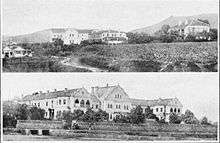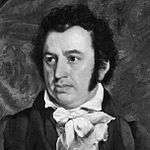Chefoo School
| China Inland Mission "Chefoo School" (Protestant Collegiate School) | |
|---|---|
 In Deo Fidimus and Nihil Absque Labore | |
| Location | |
|
Yantai, Shandong China | |
| Information | |
| Type | Private Boarding |
| Religious affiliation(s) | Protestant Christian |
| Established | 1880 (closed in 1951) |
| Athletics | Soccer, rowing |
| Website | (Japanese campus) |


The Chefoo School (traditional Chinese: 芝罘學校; simplified Chinese: 芝罘学校; pinyin: Zhīfú Xuéxiào; Wade–Giles: Chih-fu Hsüeh-hsiao), also known as Protestant Collegiate School or China Inland Mission School, was a Christian boarding school established by the China Inland Mission—under James Hudson Taylor—at Chefoo (Yantai), in Shandong province in northern China, in 1880. Its purpose was to provide an education for the children of foreign missionaries and the foreign business and diplomatic communities in China.
Principles and practice
Chefoo School was operated as a part of the China Inland Mission agency. Staff of the school were required to be full members of the C.I.M.. The curriculum was based on the British education system, heavily emphasizing classical courses designed to prepare students for entrance to British universities such as Oxford and Cambridge. Christian education was also a focus. The Principal led prayers daily, and there were two services each Sunday. The school year had four terms beginning in February, April, August and October. The school also competed in sports such as soccer and rowing. School magazines included Lux Tenebris in 1887, and The Magnet in the 1920s, and The Chefusian begun in 1928, and continued until 1942.
Origins and development
The school was connected to a sanatorium for missionaries when it began, but eventually became larger than the hospital itself. Mr W L Elliston began to teach the first three pupils in 1881. This included two sons of pioneer missionary Charles Henry Judd. Elliston was also the first Head Master. By 1886, the number of pupils grew to over 100, and there were three departments—the Boys', Girls' and Preparatory School. In 1886 the Boys' and Girls' schools were separated. The children of China Inland Mission workers alone numbered over 200 children by 1894. In 1895 a Preparatory School for children aged 5–10 was opened in premises owned by the Mission at Tong-Hsin, three miles away. In 1896 a new Boys' School was built at Chefoo, and enlargements made to the Girls' School, which was opened in 1898. By early 1900, the Preparatory school had moved closer to the main school once more. From 1909-1915, another Preparatory school operated in Lushan (Kuling), Jiangxi, in central China.
Under Head Master Pat Bruce, there were some changes at Chefoo such as the introduction of co-education in 1934; the construction of a new teaching and preparatory bloc in the same year; the creation of the Chefoo Orchestra in 1930; the teaching of Chinese Studies; and the beginning of a Girl Guides company. In 1936, Chefoo School adopted the Chinese dolphin as its crest.
The Second World War displaces the school
In 1937 Japan invaded China and Japanese Army entered Chefoo in February 1938. British and American citizens were considered as 'neutrals' at first. The school routine was not disrupted very much. Then came December 7, 1941, with the Japanese attack on Pearl Harbor. Bruce was soon arrested and the Japanese Army took control of the school property. In November 1942, staff and remaining students were interned at the Temple Hill Japanese Internment Camp.




In summer 1943, they were moved to Weihsien Internment Camp, where they remained until the camp was liberated by American paratroopers. Their fellow internee, Eric Liddell died there before the end of the war. The Americans landed on August 17, 1945, just outside the gates of the “Weihsien Civilian Assembly Center”. Three days before, the Japanese had announced their surrender, but another two weeks would pass before the surrender papers were signed. The paratroopers were sent by the Office of Strategic Services the forerunner of the CIA, to liberate 1,400 captives taken by the Japanese during the war.
Unable to land at the camp because of the guards, they made a low drop from a B-24 into a nearby cornfield. A Salvation Army band began playing "The Star-Spangled Banner" and the prisoners hoisted their rescuers onto their shoulders. Suddenly, unexpectedly, the war was over for them, and they were free. Prisoner Mary Previte recalled.
| “ | The camp went berserk. We didn't know the war was over, people were dancing, weeping, pounding the ground. | ” |
History after WWII
After the war, the Communist forces occupied north China and the school never returned to Chefoo. During the war, parts of Chefoo School were temporarily opened at Leshan (Kiating) (1941–1944), Kalimpong, India (1944–1946) and Shanghai (1946–1947). In 1947, the Mission purchased the Kuling American School and students and staff gradually returned. By the first summer, there were 126 students. By May 1949, Communist forces had occupied Kuling. The school continued under their observation until 1951. In 1951 Chefoo School in China ceased to exist. The China Inland Mission decided to withdraw completely from China, a “reluctant exodus”. Staff and students of Chefoo School withdrew to Hong Kong between February and April 1951, where missionary parents waited for their children.
Following the redeployment of missionaries throughout east Asia, the school was relocated. Chefoo schools were established in Malaysia (1952–2001), Japan (1951–1998), the Philippines (1956–1981), Taiwan (1954–1961) and Thailand (1952–1954). Chefoo School Malaysia closed down in June 2001 due to changes in demographics of mission work.
The Chefoo Schools Association was founded in 1908 to operate as an association for all former scholars and past and present members of staff of the Chefoo Schools. The Association has North American, Australian and New Zealand branches. The President (in 1998) was James Hudson Taylor III. A magazine entitled Chefoo (organ of the Chefoo Schools Association) was first published in 1908, and still continues.
Notable alumni
- Victoria Clare Attisha (née Emslie), first western female physician in Iraq from 1930 to 1970
- Alfred James Broomhall, missionary to China, historian and author
- Howard A. Hatton-linguist, translator and author, Thailand Bible Society, American Bible Society.
- Luther Carrington Goodrich. Sinologist and Columbia University professor.
- Henry Luce, American publisher
- Mary Previte, author of Hungry Ghosts, served in the New Jersey General Assembly representing the 6th legislative district from 1998 to 2006.
- Ida Pruitt, social worker and author
- Paul Thompson (sinologist), Sinologist
- Thornton Wilder, American playwright and novelist
- J. Dudley Woodberry, professor and scholar of Islam and Christian missions
- Elspeth MacKenzie, born Walker
See also
Further reading
- G Martin, Chefoo School, 1881-1951 (Merlin Books Ltd, Devon, 1990).
- Rhonda Anne Semple, Missionary Women: Gender, Professionalism and the Victorian Idea of Christian Mission (Boydell, 2003), chapter 5.
- Pigtails, Petticoats and the Old School Tie'', by Sheila Miller. Available from OMF books (history of Chefoo School produced for the centenary in 1981)
- I went to school in the jungle, by Sheila Miller (fictionalized account of life at Chefoo School, Malaysia, circa 1970)
- Historical Bibliography of the China Inland Mission
- Thompson, Larry Clinton, "Missionary Children in China: The Chefoo School and a Japanese Prison"
